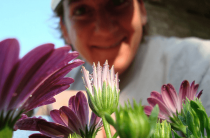Seasonal allergies are considered an allergic reaction of the body, which acts as a response of the body's immune system to foreign particles in the air. Most often, an allergic reaction occurs to those allergens that a person comes into contact with on the street (such as mold, plant pollen).
Seasonal allergies don't get that name for nothing. It manifests itself in a certain season, although sometimes it can last all year round. This happens when the allergen affects a person constantly. But often such an allergy manifests itself in the form of seasonal rhinoconjunctivitis, allergic rhinitis, bronchial asthma.
When a child has an allergic reaction to fruit puree, juices, spring and summer are considered especially dangerous seasons, as there is a high probability that the baby will develop an allergy to pollen. And even if, at first glance, it seems that nothing unites flowers and fruits with vegetables, having understood in more detail, one can come to the conclusion that pollen and fruits of plants have the same regions of protein molecules. It is they who can further contribute to the development of cross-allergy.
So, if a child has rashes on the skin, red spots after eating a little cherry jam, there is a high risk that after a walk in the forest he may develop a severe runny nose and sneezing. The same goes for citrus allergies, which can later become chamomile allergies.
Causes of seasonal allergies
Like all other types of allergies, this one is provoked by allergens that enter the body through food, water, and air. Moreover, seasonal allergies can be provoked by allergens that enter the mucous membranes of the respiratory tract and eyes along with the inhaled air. Finding out which substance is the allergen is often very difficult. After allergens have entered the body, white blood cells begin to produce antibodies, and this ultimately provokes the development of an allergic reaction. It is also called hypersensitivity to non-hazardous substances.
Pollen is considered to be one of the most common allergens that cause seasonal allergies. It is formed in flowers (the male part of the reproductive organs), and, together with the air, spreads over the area. Depending on the type of climate, plants bloom at different times. So, in some plants, pollination occurs in the spring, in others - in the summer, and in others - in the fall. The further north, the later the flowering period begins. Pollen, which is carried by insects, affects much less than allergens, which are carried by the wind.
Mold is also considered one of the most common allergens. Mold is a fairly large group of the fungi family that do not form fruiting bodies. Fungal spores are present in the air all year round, and their number depends on current conditions, and not on the season. Mold fungus can be found outdoors, indoors, and in agricultural premises. It also takes root well in moist soil, wood, plant debris. Their most common habitats are the bathroom, attic, basement and other poorly ventilated areas.
Risk factors that can trigger the development of seasonal allergies are:
- hereditary predisposition;
- bronchial asthma;
- eczema;
- periodic contact with the allergen;
- nasal polyps.
Allergens can change depending on a person's age, and symptoms can also change.
The periods of development of seasonal allergies are considered:
- spring, when hazel, plane tree, maple, birch blossom;
- summer, when flowers and cereals bloom;
- autumn, when Compositae (wormwood, quinoa, ragweed) bloom.
Early signs of seasonal allergies
Allergy symptoms can be identified even at the initial stage in order to prevent complications in time. The main signs of an allergy are:
- pollen asthma, which implies the presence of difficult breathing along with attacks of suffocation, shortness of breath;
- irritation of the upper respiratory tract, which is accompanied by a runny nose, itching, swelling of the nose, palate, sneezing, difficulty swallowing, sore throat;
- eye pathologies that are manifested by photophobia, redness, itching, swelling, skin irritation;
- multiple organ disorders, which manifest themselves in increased heart rate, increased blood pressure, Quincke's edema, dermatitis, gastritis, colitis.
- common signs - great fatigue, irritability, loss of appetite, depression, headaches, weakness.
It is worth paying attention to such a symptom as a cough, which can be the “first alarm signal” indicating the presence of an allergy. If you detect it in time and start treating it, you can completely get rid of allergies.
In general, an increase in body temperature is unusual for allergies, but some of its types are accompanied by fever.
allergic cough
The appearance of a cough with allergies most often indicates that a person has bronchial asthma, which is characterized by a narrowing of the bronchi, accompanied by suffocation. The cause of this pathology is the action of the allergen on the upper respiratory tract.
Allergic cough has the following features:
- paroxysmal character;
- sudden seizures;
- its duration is several days;
- The cough is most intense at night;
- cough accompanies a runny nose;
- color of sputum is transparent;
- cough accompanied by sore throat.
While allergic sensitization occurs, cough tremors are unproductive, so they cannot be eliminated with drugs that cause expectoration. The following symptoms complement such a cough: severe itching, pain in the throat, tearing of the eyes.
Such symptoms occur due to the release of special substances that provoke an allergic reaction. They are histamine and serotonin. They are formed due to the combination of immune system antibodies and basophils with mast cells when allergens are re-entered.
During the first contact of allergens with foreign substances, the body produces special immunoglobulins G. They settle on the surface of the above cells. Because of this, the development of allergies becomes impossible.
Immune complexes are produced under the layer of epithelium over a long period of time. It takes approximately two weeks for these antibodies to develop. After that, specific allergy symptoms begin to appear.
If the allergen re-enters the body, the following complex is formed: allergen-antibody-basophil. This compound provokes the release of serotonin and histamine. These substances provoke sensitization reactions. If the process takes place in the bronchial tree, bronchial edema may appear. These changes provoke reflex impulses of coughing and contraction of the ciliated epithelium. They continue until inflammation of the respiratory tract is observed.
After a bee or wasp sting, an allergic cough may occur, which manifests itself immediately after contact with an allergenic substance has occurred.
Food allergies can also be accompanied by a cough. Most often it occurs at night. In children, this symptom is much more common than in adults.
The parents of the child, who almost immediately established which substance is the allergen, can contribute to the fact that the allergy will disappear almost without a trace.
Algorithm for self-determination of the allergen
To identify the substance to which you have an allergy, you should be guided by the following list of actions:
- Studying the symptoms of allergies. They can be watery eyes, sore throat, sneezing, coughing, sore throat, nasal congestion. Then, when the duration of the cough is more than a week, it is worth starting to suspect the allergic nature of the disease;
- Determining the type of allergic reaction. So, if it appears once a year, you need to think about what exactly its occurrence may be connected with, or it appears several times a year at about the same time. Also, it is worth paying attention to where exactly the allergy symptoms become most pronounced: indoors or outdoors. So, allergies to wool, house dust, animal dander, fluff will be strongly manifested at home, while allergic reactions to pollen, dust will be more pronounced outdoors.
- Determination of the time of occurrence of allergies. It can be done according to the flowering calendar of plants.
Most often, it is weeds that provoke seasonal allergies, which attract little attention. Hypersensitivity can also develop on fungi - mold, rot. A large number of these substances are found on the leaves and trunks of trees. Therefore, more often allergic symptoms occur in the northern climatic zones.
seasonal allergy symptoms
Manifestations of seasonal allergies are not always frightening. In most patients, the allergic reaction is quite tolerable, it manifests itself without very obvious changes in appearance and a severe runny nose. If this is the situation, then there is no need to change the usual rhythm of life. But in the case when the allergic symptoms are very serious, it is necessary to visit an allergist. And it is necessary to carry out treatment both in the first and in the second cases. After all, immediately mild symptoms can progress and provoke the development of a very strong allergic reaction, go into bronchial asthma or an autoimmune disease.
The main symptoms of seasonal allergies are:
- severe runny nose (with clear mucus);
- sneezing
- flow into the nasopharynx;
- rhinitis;
- stuffy ears (or one ear);
- redness on the skin;
- Red eyes;
- sleep disorders;
- weakness;
- lethargy;
- rashes on various parts of the skin (mainly the groin, soft palate, conjunctiva, between the fingers, lower abdomen).
If the first symptoms of an allergy began to appear, you should not waste time and hesitate to visit a doctor. By conducting simple procedures, an experienced allergist can easily determine the type of plant that provokes allergies and negatively affects health. Skin tests are considered a diagnostic method, which provide for a set of allergens that are very common in the patient's place of residence.
Seasonal Allergy Treatment
Seasonal allergies most often do not need to be treated with any special methods, basically it is enough that the patient is prescribed simple hygiene procedures, avoiding contact with the allergen that provokes allergies. When these measures do not have the desired effect, special allergic drugs are prescribed.
The process of treating allergies should be carried out in the following sequence:
- start taking medications;
- eliminate or minimize contact with allergens;
- conduct allergen-specific therapy.
Such therapy involves reducing the patient's sensitivity to the allergen. It is carried out as follows: the allergen that provokes the disease is introduced into the body in scanty amounts, accustoming the immune system to the action of this allergen. After six months of such procedures, the patient can be completely cured of allergies.
During the treatment process, the following procedures should be carried out:
- when the weather outside is hot and windy, close the windows with gauze;
- during an exacerbation of the disease, do not spend much time outdoors;
- close the windows in the house when it is very hot outside;
- when eating in a car, do not open windows, use air conditioning;
- dry clothes after they have washed them not on the balcony, but in the apartment;
- make a list of foods that can cause cross-reactions and do not eat them;
- when entering the house from the street, take a shower or bath and wash your hair;
- install air filters in the room;
- work or walk outside in cloudy weather or only after rain;
- wear sunglasses outside
- do not use a lot of cosmetics;
- do not go near places where many plants bloom.
When the first signs of allergies were discovered, you do not need to immediately self-medicate. Indeed, sometimes it can pose a danger to human health and life. The best thing to do is to consult a professional allergist, who will be able to draw up a specific treatment regimen for a long period, which can help reduce the intensity of the symptoms or completely eliminate them.
Treatment of allergies with medications
Corticosteroid nasal sprays are commonly used to treat allergies and are generally very effective. Because they are only used topically and in small amounts, these drugs are considered very effective without causing adverse reactions (like some corticosteroid drugs). With the help of such a remedy, puffiness, itching, nasal congestion are eliminated, and do not cause drowsiness. To achieve a permanent result, you need to take them every day for a week.
One of the most common drugs for seasonal allergies are antihistamines such as Hydroxyzine, Diphenhydramine, Clemastine. They all have a relatively low cost, are sold freely, but act for a short time and cause a slowdown in the reaction. Therefore, they cannot be accepted by people who, by virtue of their profession, must drive transport. If you take them on a regular basis, the sedative effect is significantly reduced, and so is the anti-allergic effect.
Alternative drugs are Desloratadine, Loratadine, Fexofenadine. It is worth taking them much less often, and the sedative effect is almost imperceptible.
"harmful" plants
The most harmful trees are birch, alder, hazel, maple, ash. And poplar, which is considered by many to be a very allergenic tree, is generally not. An allergic reaction in people occurs not on poplar fluff, but on the pollen of cereal grasses that bloom in the same period. Poplar puffs collect allergenic pollen and carry it through the air. That is, they are not allergens as such, but perform the task of transporting them.
Immunotherapy for long-term allergy relief
To develop specific protective antibodies, special injections are injected into the human body. Such treatment is carried out until a person reaches the age of fifty, after which the immune system becomes immune. Specific immunotherapy is carried out every year if every first procedure fails. When a person's body responds well to treatment, symptoms are greatly reduced, and sometimes disappear altogether.
Aerosol for allergies
The use of aerosols is very important for allergies. The aerosol, which includes cramones, blocks the allergic cascade, it can be used without restrictions, for the reason that it is not addictive and does not carry the danger of overdose. If we talk about topical steroids, then in this case the safety of treatment will depend on the specific situation. With seasonal allergic rhinitis, you need to start using such a spray ten days before the start of flowering, directly during the flowering period, and after it has ended. Sometimes these drugs are used for more than a year, but most often it does not need to be done for that long.
Factors that cause seasonal allergies
Meteorological factors have a very significant impact on the health of allergy sufferers. So, under rainy weather conditions, pollen is nailed to the ground, and therefore its concentration in the air is small. At the same time, when it is very hot and windy outside, the concentration of pollen in the air is very high.
Pollen concentrations are much lower indoors than outdoors. Thanks to this, allergy sufferers breathe much easier indoors than outdoors. But in the case when a person constantly ventilates the room, drives his own car with open windows, the concentration of pollen even in the premises becomes similar to that on the street. And so it is equally bad for a person both indoors and outdoors.
Prevention of seasonal allergies
Healing measures and symptomatic therapy should be carried out for those people who suffer from hay fever. A very large role in the development of allergic reactions belongs to the region where a person lives. Therefore, the solution for some people may be to move from their place of residence during the flowering of plants.
The patient should avoid contact with suspected or already detected allergens. This can be achieved by installing special air filters. It is also necessary to tightly cover doors and windows, in the event that it is impossible not to contact with the allergen, use protective bandages on the mouth, nose, and gloves.
You need to take a shower often, change clothes, arrange wet cleaning. It is best to remove all curtains, rugs, carpets, and other things from the house that can accumulate a significant amount of dust.
If a person's symptoms are mild, it will be enough that he begins to rinse his nose and gargle with slightly salted water (a spoonful of salt is added to a glass of water). To relieve itching in the throat, eyes, reduce a runny nose, you can take antihistamines, which are available without a prescription. They have a suspending, slowing down reaction effect, therefore, after taking them, you should not drive a car or other vehicle and mechanisms with increased danger.
If this treatment is not enough to get rid of acute or persistent symptoms, it is necessary to carry out medical treatment, not only in order to eliminate the signs of the disease, but also for prevention.
Staying in a "clean room"
For a patient suffering from seasonal allergies, a way out of the situation may be to stay in a room with a dust-free environment. Such a room is a hermetic glazed box into which air passes through filters, which does not contain any particles, bacteria or dust. In such a room, the symptoms of hay fever disappear after a couple of days. This method has no side effects. The essence of the procedure is for a person to simply read or do nothing for a couple of hours.
At first, the procedure does not give a long-term effect, and therefore the person feels weak and unwell again when new allergens begin to bloom. But if such procedures are carried out systemically for 3-4 years, the immune system will get stronger enough to resist pollen allergy.
















I have year-round allergies for 3 years